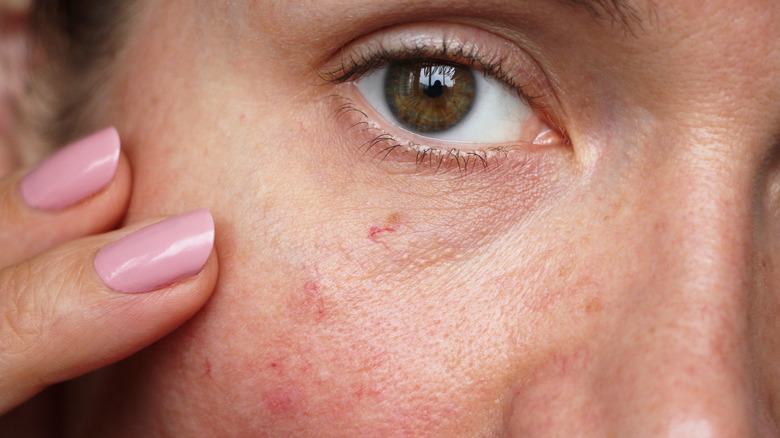What It Really Means When You Pop A Blood Vessel
While they may be annoying, those tiny red branching lines on your face from broken blood vessels — also known as 'spider veins' — are not usually cause for serious concern. When blood vessels break, they leak a small amount of blood into the skin, leaving visibly red or purple bruises, dots, lines, or patches. Usually, blood vessels break because of injury, but there are a number of other possible causes too (via Palm Vein Center).
If physical injury has been ruled out, heavy sun exposure is another likely cause of spider veins. Beverly Hills dermatologist Dr. Tsippora Shainhouse notes via Zwivel, "The constant damage to the skin caused by chronic sunburn forces it to try to recover and repair itself by making new vessels. The UV also breaks down collagen, making the vessels more apparent." Yet another reason to make sunscreen a part of our daily skincare routine.
Using sunscreen helps protect blood vessels
Other possible causes of broken blood vessels include: allergic reactions, autoimmune disorders, genetics, pregnancy, side effects of certain medications, and even alcohol use. Dr. Jennifer Chwalek, a board-certified dermatologist at Union Square Laser Dermatology, says, "Anything that increases blood flow to the face may cause broken blood vessels. That's why people sometimes notice them after vomiting or overexertion. I once got a broken blood vessel after a prolonged backbend in a yoga class," (via Martha Stewart).
If the cause of the bruising or redness is obvious (maybe the coffee table needs relocating if you're constantly stubbing your toe on that pesky table leg in the middle of the night), then it should clear up by itself without any special medical attention. If possible, elevate the injured body part, apply an ice pack, and take acetaminophen or ibuprofen to help ease any pain (via Medical News Today). For spider veins that just won't go away, a dermatologist can recommend a variety of treatments, including laser therapy, that can help.
But on the other hand, if you have no idea what caused the broken blood vessels to occur, if the redness doesn't seem to be going away, or if there's pain, swelling, or itchiness around the impacted area, contact your doctor. It could be a sign of a more serious underlying condition.


